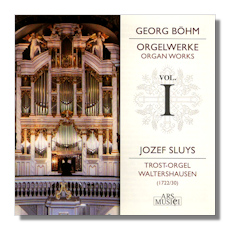
The Internet's Premier Classical Music Source
Related Links
- Böhm Reviews
- Latest Reviews
- More Reviews
-
By Composer
-
Collections
DVD & Blu-ray
Books
Concert Reviews
Articles/Interviews
Software
Audio
Search Amazon
Recommended Links
Site News
 CD Review
CD Review
Georg Böhm

Organ Works I
- Chorale Variations "Herr Jesu Christ, dich zu uns wend"
- Chorale Variations "Auf meinen lieben Gott"
- Chorale Partita "Ach wie nichtig, ach wie fluchtig"
- Chorale "Vater unser im Himmelreich"
- Chorale Partita "Gelobet seist du, Jesu Christ"
- Chorale "Nun bitten wir den heiligen Geist"
- Chorale Partita "Freu dich sehr, o meine Seele"
- Chorale "Allein Gott in der Hoh sei Ehr"
Jozef Sluys, organ
Ars Musici 232342
Georg Böhm was a rough contemporary of Bach, living from 1661 to 1733 – mostly in Thuringia (like Bach). He studied with Reincken (1623-1722) in Hamburg. In his "Obituary" Johann Sebastian Bach was "quoted" (apparently speaking to his son, Carl Philipp Emanuel) as "… loving and studying the works of the Lüneburg organist Georg Böhm." Indeed, Bach was a pupil of Böhm's for a time. You can both listen to this CD with such influences in mind and to Böhm's works in their own right. If you're not familiar with them and their composer, this CD from Ars Musici (and its companion, the second volume in the series Ars Musici 232373), is an excellent place to start. Especially since there are no other CDs currently available devoted specifically to Böhm's organ music.
His instrumental works are for harpsichord, for organ (preludes, fugues, chorale preludes and a capriccio) and for harpsichord or organ. Where chorales are concerned, three types are commonest: fugal, ornamented and with variations. Then several of the latter are treated like partitas… examples on this engaging CD by Belgian organist Jozef Sluys are Ach wie nichtig, ach wie fluchtig [tr.3], Gelobet seist du, Jesu Christ [tr.5] and Freu dich sehr, o meine Seele [tr.7]. These are closest to harpsichord writing in style. Herr Jesu Christ, dich zu uns wend [tr.1] and Auf meinen lieben Gott [tr.2] are examples of chorales with variations. Perhaps the form most conducive to Böhm's considerable powers of expressivity is the ornamented one. Examples here are Vater unser im Himmelreich[tr.4] and Nun bitten wir den heiligen Geist[tr.6]. There is no unbridgeable chasm between this form and the others. Nor does the organ only "come alive" in the ornamented chorales. But these pieces do display a degree of invention and insight into the capabilities of the organ that must have inspired Bach as he moved in the same world.
Jozef Sluys was born in 1936. Here he plays the Waltershausen organ built by the great court builder, Heinrich Gottfried Trost dating from the 1720s. It represents one of the finest (extant) organs of the period. Of the three manuals, 53 speaking stops, 2,806 pipes almost three quarters is preserved in its original state, although restored in the late 1990s. This just-released CD was actually recorded in 2001. The sound is authoritative and at the same time has great presence. The audible mechanics are breathy yet contribute to our enjoyment. Not least because we feel we are listening to the kind of instrument which Bach too must have regarded as close to ideal.
Sluys' playing is keen yet stately. His tempi are as measured as his sense of phrasing is correspondingly august. In the case of the variations, for example – and the magnificent Freu dich sehr, o meine Seele [tr.7] (the longest work on the CD, at nearly 17 minutes) – the successive rounds all build on one another. He unselfconsciously provides a reason for each one. There is a sense of cumulative purpose… "I've just said that so this is what logically comes next." Or not necessarily logically – but appropriate to the tone and direction of the work. By the end of this Partita Sluys has managed to make you feel an affection for Böhm as a person, as well as admiration for his gifts as a composer. What's more, the order in which Sluys has chosen to play the eight works on this CD, ending with the triumphant and extrovert Allein Gott in der Hoh sei Ehr, adds to the sense that we're listening to a recital into which has gone careful thought commensurate with the achievement of the music's composer.
The acoustics on the CD are just right. There's room yet focus – on the import of the organ's melodies and tonality. The photograph on the cover of the short but informative liner notes shows just what a magnificent organ the Trost Waltershausen is. Yet Sluys brings what might otherwise be at best a grandiose, or even an intimidating, instrument into the measure of one which provides pleasure and inspiration. And not only for Bach. He makes it plain that Georg Böhm is a composer worthy of our attention in his own right. Recommended.
Copyright © 2010 by Mark Sealey.





















